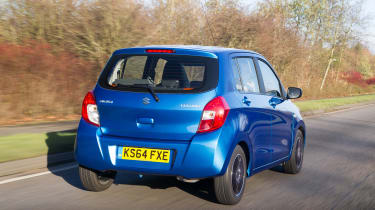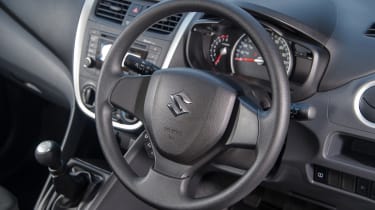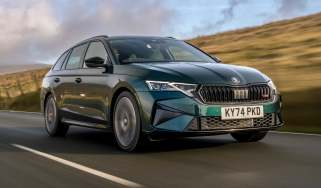Suzuki Celerio review
The Suzuki Celerio offers super city car value, offering practicality, economy and lots of kit

The Suzuki Celerio is the smallest car that Suzuki has on sale. It's a city car, but it's slightly larger than many of its rivals, so offers a bit more practicality than the city car norm.
Those rivals consist of the SEAT Mii/Skoda Citigo/VW up! trio, the Hyundai i10, Kia Picanto, the Citroen C1/Peugeot 108/Toyota Aygo joint models, the Renault Twingo, Fiat Panda, Vauxhall Viva and Ford Ka+. Another model that coud be worth considering is the Dacia Sandero, which offers no-frills motoring in a cheap supermini-sized package. That's a lot of diverse rivals, but the Celerio sets its stall as a budget model with a simple range and efficient petrol power.
• Cheapest cars on sale: Suzuki Celerio
The Celerio is the successor to the Alto, a name that has plenty of history from Suzuki's past. It only comes as a five-door, and while the Celerio is built in Pakistan and India, UK cars are assembled in Thailand. Prices for the Celerio start from around £8,000 and rise to around £9,700, which is pretty good value for a top-of-the-range model. Suzuki brands the Celerio trims nice and logically as SZ2 and SZ3, while special edition versions occasionally come and go from the range.
More reviews
Car group tests
In-depth reviews
Road tests
Used car tests
Standard kit for the SZ2 includes central locking, a DAB radio with CD player, space for five with three seatbelts in the back, a 60:40 split-folding rear seat and a height adjustable driver's seat. That's pretty modest, but not all rivals will necessarily have these fundamentals on offer. The SZ3 adds alloy wheels, Bluetooth and air conditioning, while the sole option on both cars is metallic paint, including Suzuki's vivid Cerulean Blue hue, for less than £500. If you want rear parking sensors on both models, or alloy wheels on an SZ2, then you'll need to browse the Celerio's accessories brochure.
Power comes from a 1.0-litre three-cylinder naturally aspirated petrol engine with 67bhp. In typical city car fashion, power goes to the front wheels through a five-speed manual gearbox. Suzuki did offer its AGS automatic in the Celerio, but this is no longer available.
The Suzuki Celerio is a no-nonsense kind of city car. It does the job it's designed for, and should prove to be a reliable motor with respectably low running costs. It probably won't be as exciting to drive as its contemporaries, but it's a safe, secure machine that will get up to five occupants from A to B with the minimum of fuss.
Low prices mean it'll be attractive to buyers on a budget, and while a three-star Euro NCAP rating reflects the lack of advanced safety tech on board, it by no means that the Celerio is unsafe.
Engines, performance and drive
Unlike the larger Suzuki Swift supermini, there’s no small car magic to the way that the Celerio drives. This is a more practical and restrained choice for people who want a comfortable, usable city car that steers and rides safely and securely, rather than offering any kind of fun. With an elevated driving position compared to many compact hatchbacks, the view of the road ahead is great, meaning you can place the car on the road easily.
There are 14-inch wheels fitted at each corner and relatively high-profile tyres, so the Celerio's low-speed ride around town is smooth. However, if you push harder and hit bigger bumps at speed the Celerio loses some of its composure.

Body rolls in corners is significant, due to the squidgy rubber and lofty height compared to some lower-slung city car rivals. The steering isn’t all that precise either – you always feel like you have to turn the wheel more than you expect to go round a bend.
There’s lots of steering lock, though, which means the Suzuki has a small turning circle at 9.4 metres. Combined with the impressive all-round vision, the Celerio is simple to park and manoeuvre in tight spaces.
Engine
With 67bhp from its 1.0-litre three-cylinder petrol engine, a 0-62mph time of around 13 seconds isn't particularly quick, while the Celerio has a top speed of 96mph. With only 90Nm of maximum torque at 3,000rpm, it's not particularly punchy and needs to be worked hard to get up to motorway speeds. However around town it's nippy and responsive if you keep it in lower gears, although this will have an adverse effect on fuel economy.
The five-speed gearbox is reasonable to use, although it's a bit on the notchy side.
MPG, CO2 and Running Costs
With only two models to choose from, the SZ2 and SZ3, and both of them featuring a modest amount of kit, the Celerio is one of the cheapest cars on sale in the UK. Prices start at around £8,000, and the top-spec model comes in at well under £10,000, while the only option to speak of is metallic paint.
Every city car on sale in the UK offers rock-bottom running costs, and the Suzuki Celerio is no exception. The simplified range and single engine choice means all cars have CO2 emissions of 99g/km. This helps keep the list price down because first-year road tax is only £55. But thanks to the road tax changes in 2017, the Celerio is no longer road tax exempt, and it costs the same £140 as any other city car.
Suzuki offered a more efficient Dualjet version of the Celerio for a while. This offered 78mpg and just 84g/km CO2 emissions, but the latest business and road tax rules mean it no longer offers the tax benefits it once did, so it was dropped.
Still, the 1.0 is still pretty economical at 65.7mpg on the combined cycle (based on the older NEDC test), while a 35-litre fuel tank means there's a feasible range of 500 miles if you get close to this.
Insurance groups
All Celerios fall into insurance group 7, which is at the higher end of the city car insurance spectrum.
Depreciation
The Suzuki boasts reasonably strong residuals, with all versions retaining around 39 per cent of their value after three years. While that’s not much on an £8,000 car, it means you’re likely to get some money back when you do decide to trade in. Cheap insurance and servicing costs also help to minimize the impact on your wallet.
Interior, design and technology
The Suzuki Celerio isn’t going to win any beauty contests. It’s a fairly inoffensive design, but the high level of standard equipment means personalisation options are largely limited to which paint colour you choose – rivals offer far more in terms of extra kit and trim combinations.
The Celerio is a better looking and better proportioned car than the Alto and Splash models it replaced, but it can’t match the Renault Twingo or Toyota Aygo in the style stakes. While its boxy body offers bags of interior space, it looks quite slab-sided next to Peugeot’s dinky 108 or the classy Volkswagen up!.
Unlike some rivals, there are no personalisation options on offer. The £465 optional metallic paint is the only real way of expressing any extra flair on the Suzuki. An alternative alloy wheel design is available on the accessories list.
Compared to the subtle exterior design, the Celerio’s cabin is busier, with a mix of colours, materials and textures that makes things feel cheap. However, despite the bargain bin plastics, build quality is strong. The dash swoops down to a big centre console that houses the radio and heating controls, while there’s a USB socket underneath and a handy space to leave your phone when charging.
Silver plastic highlights run round the bottom of the dash in a U-shape, plus there are more bright inserts for the top of the gearlever and air vent surrounds. It’s a small touch that adds a splash of contrasting colour to an otherwise drab and plasticky cabin.
If you want air conditioning, the SZ3 is the model to go for, as it's not offered on the SZ2.
Sat-nav, stereo and infotainment
Both versions of the Celerio get a basic two-speaker stereo with DAB radio, Bluetooth, a USB connection and CD player. There's no option to add sat-nav, but at least that USB socket means you can charge your smartphone while you're using it. Unlike some rivals, you'll have to buy a phone cradle to mount it on the dashboard or windscreen, though.
Practicality, comfort and boot space
The Celerio has the biggest boot in its class, and there’s enough room for five passengers at a push. The slab-sided looks work in the Suzuki’s favour here, allowing for plenty of headroom, while the generous wheelbase means there’s enough knee space for six-foot tall passengers in the rear. Usefully, the driver’s seat adjusts for height - not all city cars get this option - so it shouldn’t be too difficult to get a comfortable driving position.

Size
The Celerio measures 3,600mm long, 1,600mm wide and 1,540mm tall, which gives it dimensions that are slightly bigger than those of some city car rivals. Only the Ford Ka+ and Fiat Panda can boast larger dimensions.
Leg room, head room & passenger space
There's good head and legroom in the Celerio, helped by the car's tall roof line. Shoulder space will be a bit tight when travelling three-up in the back, but it's acceptable for short journeys. Space up front is good, plus there's a tray under the USB slot to put your phone, as well as 2 cup holders, while there are 3 cup holders in the back. There are small door bins and a reasonable glove box, too.
Boot
At 254 litres, the Celerio's boot is three litres larger than the one in the VW up!, Skoda Citigo and SEAT Mii trio, and two litres bigger than the previously class-leading Hyundai i10. It’s a decent shape, too, although the 60:40 split folding seats don’t fold flat and there’s a really annoying lip at the base. That won’t be an issue for most, but it’s certainly worth noting if you plan on carrying larger items on a regular basis.
Under the floor you'll find a tyre repair kit, but there's no option to add a spare wheel.
Reliability and Safety
Sales of the Celerio got off to a shaky start: just one day after the car hit dealers, Suzuki had to recall all models to rectify a potential problem with the vehicle’s braking system. However, the fix was carried out quickly and the brand is confident safety won’t be affected.
• Cheapest cars to run: Suzuki Celerio
Overall safety levels aren’t too impressive, though, with the Celerio only scoring three stars in its Euro NCAP crash test in 2014. Its category scores were 61 per cent for adult occupant protection, 74 per cent for child occupants, 68 per cent pedestrian safety and 38 per cent for safety assist.
Standard safety kit comprises four airbags (there are no curtain bags), electronic stability control, tyre pressure monitors and Isofix child seat anchors in the back. But Suzuki doesn't offer any advanced kit such as autonomous city braking, adaptive cruise or blind spot detection.
The Driver Power survey has revealed that Suzuki's dealer network is one of the UK's best, placing fourth in the 2018 franchise rankings. Owners praised the company in a number of categories, and one area that impressed was the standard of work carried out, which put Suzuki in forst place ahead of 27 other dealers.
Warranty
All Suzukis come with a 3-year/60,000-mile warranty, and there's 12-year anti perforation cover, too. There are three levels of extended warranty on offer: Basic, Select and Comprehensive, all of which are available on Suzukis that have covered less than 100,000 miles.
Servicing
Service intervals for the Suzuki Celerio are every 12 months or 9,000 miles, although that mileage limit is 1,000 miles short of rivals such as the Toyota Aygo and Skoda Citigo. Suzuki offers service packages that allow you to pay monthly for servicing and maintenance. These are available from your local Suzuki dealer.
For an alternative review of the latest Suzuki Celerio Hatchback visit our sister site carbuyer.co.uk








